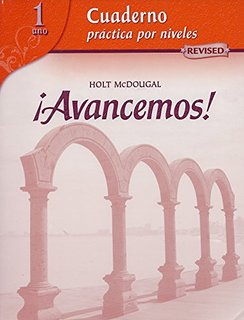
All Solutions
Page 52: Vocabulario C
The purpose of this exercise is to practise Spanish vocabulary and writing.
Four different classes are listed for this exercise. You have to say what you have to do for each in order to get a good mark. By now, you have learned that the verbal phrase “tener que + infinitivo” has precisely the meaning you need for this exercise: “have to + infinitive”. Think of all the school-related vocabulary you acquired by now and use it in the above formula to create sentences. Since this is a personal question addressing yourself and aiming at a current condition, you will use “tengo que + infinitivo” in all four responses.
There are many ways to answer these questions adecuately, thus only refer to the below examples as a reference of how your sentences might look like.
1. En las clases de español, tengo que escuchar, escribir y conversar mucho en español para sacar una buena nota.
2. En las clases de matemáticas, tengo que estudiar mucho para sacar una buena nota.
3. En las clases de ciencia, tengo que tomar muchos apuntes para sacar una buena nota.
4. Para las clases de inglés, siempre tengo que hacer la tarea para sacar una buena nota.
The objective of this exercise is to practise writing in Spanish.
Six questions are given in this exercise. You will read them carefully and respond in full sentences. The questions refer to a current condition, thus you will respond in the present tense. Examples will be provided in the following paragraph. Since these are all personal questions, only refer to the examples as a reference of how your sentences should look like.
1.A. Sí, me gusta usar la computadora en la clase de español.
1.B. No. no me gusta usar la computadora en la clase de español.
Then, in Spain, the verb “utilizar” is more frequent than “usar”, even though the latter is used, but in different contexts.
Finally, given that there are a number of native languages spoken in Spain, the word “español” refers to any of them. For example: “El gallego es un idioma español.” (Galician is a Spanish language.). In this example, “español” refers to the Kingdom. The language you are learning comes from Castille, a historical region in Spain, and is therefore Castillian (“castellano”). Given that only Castillian made its way from Spain to the Americas, it is only logical that the American peoples call it Spanish rather than Castillian since there is no need to differentiate between languages.
Given all of the above, the first example would look like this in Spain:
1.A. Sí, me gusta utilizar el ordenador en la clase de castellano.
1.B. No, no me gusta utilizar el ordenador en la clase de castellano.
To confirm, both pairs of sentences mean exactly the same.
2.B. No, no me gusta hablar en la clase de español.
3.A. Sí, me gusta dibujar en la clase de arte.
3.B. No, no me gusta dibujar en la clase de arte.
4. Mi clase de matemáticas es a las diez menos cuarto.
5.A. Sí, me gusta leer libros en la clase de inglés.
5.B. No, no me gusta leer libros en la clase de inglés.
6. La maestra de ciencias es joven, alta y guapa. Tiene el pelo castaño y es atlética. También es una persona muy organizada.
The purpose of this exercise is to practise writing in Spanish.
Take your school schedule and have a look at your afternoon classes. You will write down what you see in full sentences. An example will be provided below. Given the personal nature of this question, only refer to the example as a reference of how your sentences might look like.
A veces no tengo clase desde la una hasta las dos y media de la tarde. Otros días a esa hora tengo la clase de música. Todos los días tengo la clase de español a las tres menos cuarto. Después, de vez en cuando voy al gimnasio a practicar deportes o voy con mis amigos a la cafetería.

